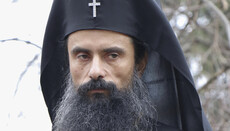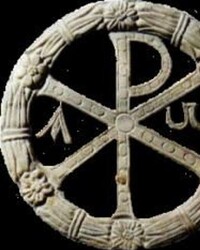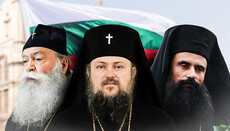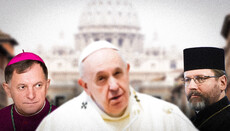How ROC took half of Polish Church: the second answer to Abp. Chrysostomos
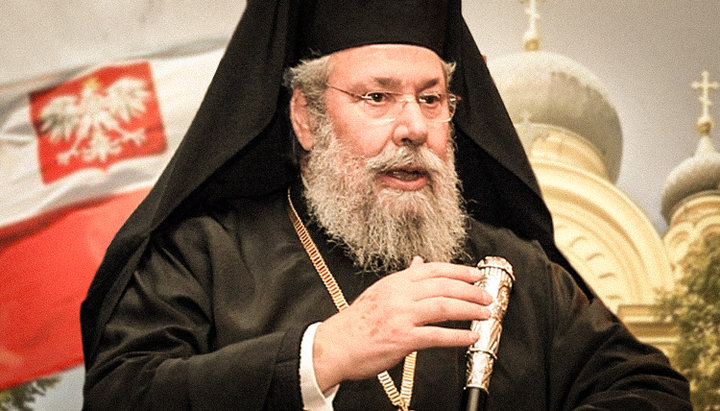
We analyze in detail the accusations of the Cypriot Primate against the Russian Church. This article is about the "half of the Christians from Poland" taken away.
We continue to respond to the “temniki” (gag orders – Trans.) of the Phanar voiced by the Primate of the Church of Cyprus, Archbishop Chrysostomos, addressed to the Russian Church. In the previous publication, we examined in detail the accusations of the Primate of Cyprus that the Russian Orthodox Church "took" two dioceses from the Georgian Church, now we turn to the Polish Сhurch, from which, according to Abp. Chrysostomos, the Russian Church "took half of the Christians".
We recall that in early November, the Archbishop unilaterally, contrary to the previous decision of the Synod of his own Church, recognized the so-called "Orthodox Church of Ukraine", commemorating its "Primate" at the Liturgy, which caused divisions within the Church of Cyprus.
Following this, Abp. Chrysostomos, in communication with the mass media, made a number of very strong statements both in relation to the Russian Orthodox Church and in relation to the bishops of the Church who disagreed with his recognition of Ukrainian schismatics.
The accusations he made were, on the one hand, paradoxical. On the other hand, they are obviously aimed at discrediting the Russian Church in the eyes of the Orthodox world. In particular, the obvious task of such accusations is to separate the Russian Church from other Local Churches: Georgian, Polish, Romanian and others.
Despite the absurdity of the accusations, we cannot ignore them, since the Phanariots use similar "compromising evidence" on the sidelines when negotiating with the Local Churches, which means there is a need for a public and detailed answer from our side.
The quote with Vladyka Chrysostomos's accusations reads as follows: “After the Fall of Communism, the Ecumenical Patriarchate asked the Russian Orthodox Church to return to the pre-1917 status, which was denied by the then Patriarch of Moscow, Alexy. And now they behave like that. Asking the Ecumenical Patriarch: Since the codices exist, why does it (the Moscow Patriarchate – Ed.) interfere? I know that today it took over two dioceses from Georgia, two dioceses from Ukraine, he took over half of Christianity from Poland, he took dioceses from Romania. Who gave them the right to set up an autocephalous Church in America? These interventions of others in the jurisdictions brought upheaval throughout Orthodoxy."
"It (the Moscow Patriarchate) accepted more than half of Christians from Poland"
Abp. Chrysostomos's complicated manner of presenting accusations is again perplexing. Only by means of exclusion can we assume that it goes about the events of 1939 when the Stalinist USSR annexed the lands of Western Ukraine and Western Belarus. Following this, the dioceses of the Russian Orthodox Church were created in these territories. For some other versions of the charges of the Cypriot Primate, there are simply no historical prerequisites.
Perhaps, it is worth starting with the fact that the Polish Orthodox Church does not have and does not express any claims on this issue to the ROC.
It is also worth asking a question to Archbishop Chrysostomos: since now you, together with Patriarch Bartholomew, recognize the "Orthodox Church of Ukraine" and believe that all of Ukraine falls under its jurisdiction, then maybe you will convince to "return" Western Ukrainian dioceses to the Polish Church, based on your opinion, that they were "taken away" from the Polish Church? Or now, according to tradition, you will refer to Apostolic Canon 34, which the OCU likes to refer to – that “every independent state should have its own Church”?
So, based on the same canon, after the inclusion of these territories in the USSR, the jurisdiction of the Russian Church was restored over them.
However, the whole point is that the existence of the autocephalous Polish Orthodox Church in 1939 is believed only in Constantinople. In the Russian Church, as in the Polish Church itself, it is believed that a non-canonical schism took place at that time. That is, in other words, no autocephalous Polish Church existed.
Historical background:
Since 1918, the Polish authorities (the nationalist regime of Piłsudski) had blocked access to Poland for bishops from the USSR. At this time, the Russian Church decided to create an autonomous Church in Poland from the dioceses located on its territory.
And here it is appropriate to recall Apostolic Canon 34, as well as Canon 17 of the IV Ecumenical Council, which Phanar likes to refer to. Both of these canons stipulate the organization of church borders:
“The bishops of every nation must acknowledge him who is first among them and account him as their head, and do nothing of consequence without his consent; but each may do those things only which concern his own parish, and the country places which belong to it....” (Apostolic Canon 34), ".... If, on the other hand, any city has been rebuilt by imperial authority, or has been built anew again, pursuant to civil and public formalities, let the order of the ecclesiastical parishes be followed." (Canon 17 of the IV Ecumenical Council). It is these norms that supporters of the creation of new autocephalous Churches often refer to.
Their essence is as follows: church borders follow political ones. However, in fact, not a single church canon defines words like "autocephaly", "autonomy", "self-government", "exarchate." That is, canon law determines the need to create an ecclesiastical structure in each state, but does not determine whether it should be autocephalous, autonomous, self-governing, or a metropolis. The history of the Churches, as well as their present day, clearly testifies to this. The Church of Constantinople has three autonomous Churches (in the USA, Finland and Estonia) and numerous metropolises in different countries. Also, as in the ROC, there are various structures with varying degrees of independence in Japan, China, Central Asia, Ukraine, Belarus, Estonia, Latvia, Lithuania, etc.
That is why in 1918, after the emergence of independent Poland, the Moscow Patriarchate proclaimed the autonomy of the Polish Church. However, the Polish authorities took a course to separate the Polish Church from the ROC, and at the same time to oppress Orthodoxy. Orthodox churches were seized and given over to Catholics.
In January 1922, the First Bishops Council of the Polish Church took place, in May – the Second Council, and in mid-June of the same year – the Third Council.
"This Council was opened by the speech of the Minister-President of Poland, who expressed the government's wish on the need for a hierarchical structure of the Orthodox Church in Poland and the urgent adoption, in view of the removal of the canonical power of the Orthodox Church in Moscow, a decision on the independence of the Orthodox Church in Poland on the basis of autocephaly," wrote the bishops of the Orthodox Metropolis in Poland to Patriarch Tikhon on August 16, 1924.
“Thus, now there is no longer any reason to doubt that the autocephaly of the Polish Orthodox Church arose in 1924 under obvious pressure from the Piłsudski government, and this pressure could only be dictated by the goals of Polonization of the Russian Orthodox population of Poland and the enslavement of the Orthodox Church to the Vatican through the union. It is now also clear that Patriarch Meletius IV of Constantinople, for some political or other purposes, went to meet these intentions of the Polish government, approving the autocephaly of the Polish Orthodox Church without the consent of the Russian Mother Church, which only this right belonged to according to the canons," wrote Anatoly Vedernikov, Associate Professor of the Moscow Theological Academy, about this situation.
Constantinople Tomos for the Polish Church
In 1924, the Polish Church received the Tomos of autocephaly from the Church of Constantinople. The reasons for this in the tomos are as follows: “Having lovingly considered this request, taking into account the prescriptions of the holy canons, which establish that the organization of church affairs should follow political and social forms (Canons 17, 28 of the IV Ecumenical Council), as well as Photios' Apothegm: 'It is accepted that the rights related to church affairs, and especially to the affairs of parishes, must conform to political and administrative changes', on the other hand, obeying the urgent voice of the canonical duty to care for the Orthodox Churches in need, imposed on Our Holy Ecumenical Throne; considering equally the fact, which history also agrees with (for it is written that the first separation from Our Throne of the Kiev Metropolis and the Orthodox Metropolises of Lithuania and Poland that depend on it, as well as their aссession to the Holy Moscow Church, did not take place according to the prescriptions of the canonical rules, nor was observed all that was agreed upon regarding the full ecclesiastical autonomy of the Metropolitan of Kiev, bearing the title of Exarch of the Ecumenical Throne), our Нumbleness and holy metropolitans, our beloved brothers and co-ministers in the Holy Spirit, considered it a duty to heed the request made by the Holy Orthodox Church in Poland and give Our blessing and approval for her autocephalous and independent arrangement."
To analyze subsequent events, it is important for us to remember these grounds and understand them. They are important for understanding both the church history of the twentieth century and the actions of the Church of Constantinople towards Ukraine that have already followed nowadays. As we can see, the Phanar uses almost identical grounds both in 1924 in the Polish situation and in 2018 in relation to Ukraine. Therefore, these grounds are important as it is the history of Poland that is the first clear attempted aggression by the Church of Constantinople on the territory of other Local Churches. Let's consider them carefully:
1. Challenging the validity of the Tomos of 1686 on the transfer of the Kiev Metropolis (which then included part of Poland) under the jurisdiction of the Moscow Patriarchate.
2. Photios' Apothegm.
3. Canon 17 of the IV Ecumenical Council.
4. Canon28 of the IV Ecumenical Council.
With regard to the attempt to nullify the value of the Tomos of 1686, we will cite the statement of the Synod of the Russian Orthodox Church on the Ukrainian situation in 2018:
“The 1686 Act confirming the Metropolis of Kiev as part of the Moscow Patriarchate and signed by His Holiness Patriarch Dionysius IV of Constantinople and the Holy Synod of the Church of Constantinople is not to be reviewed. The decision to ‘repeal’ it is canonically negligible. Otherwise, it would be possible to annul any document defining the canonical territory and status of a Local Church, regardless of its antiquity, authoritativeness and common ecclesial recognition.
The 1686 Synodal Deed and other documents that accompany states nothing about either a temporary nature of the transfer of the Metropolis of Kiev to the jurisdiction of the Moscow Patriarchate or that it may be cancelled. The attempt of hierarchs of the Patriarchate of Constantinople for political and self-seeking reasons to review this resolution now, over three hundred years after it was adopted, runs contrary to the spirit of the Orthodox Church’s canons that do not allow of a possibility for reviewing established church boundaries that have not been challenged for a long time. Thus, Canon 129 (133) of the Council of Carthage reads, ‘If anyone… brought some place to catholic unity and had it in his jurisdiction for three years, and nobody demanded it from him, then it shall not be claimed from him if also there was a bishop during these three years who should have claimed it but kept silent’. And Canon 17 of the Fourth Ecumenical Council establishes the thirty years’ term for a possible conciliar consideration of disputes over the belonging of even particular church parishes: ‘Parishes in each diocese… shall be invariably under the power of bishops who manage them, especially if for thirty years they undoubtedly were under his jurisdiction and governance’.”
Note that in the issue related to the Ukrainian expansion of Constantinople in 2018, the Russian Church refers to the same Canon 17 of the IV Ecumenical Council, to which Constantinople itself referred during its expansion to Poland in 1924 ... Later we will return to this important point.
In addition, it should be taken into account that in 1924 the borders of Poland (and the proclaimed POC) did not at all fit into the boundaries of the Kiev Metropolis of 1686 but significantly exceeded them.
We will not dispute "Photios' Apothegm". Although the Russian Church, in response to the Polish Tomos of Constantinople, challenged it since it was not approved by any of the Councils and, therefore, has no canonical significance for the Church. We'll just remember it.
Analysis of Canon 28 of the IV Ecumenical Council
A separate role is played by Canon 28 of the IV Ecumenical Council. So, in particular, in 1924, granting the Tomos of autocephaly to the Polish Church, the Phanar referred precisely to it:
“Everywhere following the decrees of the Holy Fathers, and aware of the recently recognized Canon of the one hundred and fifty most God-beloved Bishops who convened during the reign of Theodosius the Great of pious memory, who became emperor in the imperial city of Constantinople otherwise known as New Rome; we too decree and vote the same things in regard to the privileges and priorities of the Most Holy Church of that same Constantinople and New Rome. And this is in keeping with the fact that the Fathers naturally enough granted the priorities to the throne of Old Rome on account of her being the imperial capital.
And motivated by the same object and aim the one hundred and fifty most God-beloved Bishops have accorded the like priorities to the Most Holy throne of New Rome, with good reason deeming that the city which is the seat of an empire, and of a senate, and is equal to old imperial Rome in respect of other privileges and priorities, should be magnified also as she is in respect of ecclesiastical affairs, as coming next after her, or as being second to her.
And it is arranged so that only the Metropolitans of the Pontic, Asian, and Thracian dioceses shall be ordained by the Most Holy Throne of the Most Holy Church of Constantinople aforesaid, and likewise the Bishops of the aforesaid dioceses which are situated in barbarian lands; that is to say, that each Metropolitan of the aforesaid dioceses, together with the Bishops of the province, shall ordain the Bishops of the province, just as is prescribed by the divine Canons. But the Metropolitans of the aforesaid dioceses, as has been said, are to be ordained by the Archbishop of Constantinople, after the elections have first been conducted in accordance with custom and have been reported to him.”
The Orthodox Church of Constantinople interprets this canon as an indication of a certain primacy of power in universal Orthodoxy. However, if we look closely at the text of this canon, we will see the following:
First, the Fathers of the Council refer to the Canon 3 of the II Ecumenical Council: "Let the Bishop of Constantinople, however, have the priorities of honour after the Bishop of Rome, because of its being New Rome." As we can see, it clearly talks about the primacy of honour, and not about the primacy of power. In case, contrary to the text of the canon, we should admit that for some reason it goes about the primacy of power, then we will have to admit that the Bishop of Rome possessed it, and therefore the claims of the popes to the primacy of power were justified, which was rejected by the Church, including Constantinople.
In case, contrary to the text of the canon, we should admit that for some reason it goes about the primacy of power rather than honor, then we will have to admit that the Bishop of Rome possessed it, and therefore the claims of the popes to the primacy of power were justified.
Secondly, the Fathers of both Councils clearly define the reason for this primacy of honour: "because of its being New Rome", "on account of being the imperial capital", "with good reason deeming that the city which is the seat of an empire and of a senate". That is, a quite clear political reason for that time is given: the transfer of the capital of the Empire from Rome to Constantinople, which makes the Throne of the Constantinople Bishop a metropolitan one. Let us recall that at the time of both the Second and the Fourth Ecumenical Councils, all autocephalous Churches were within and on the borders of the Byzantine Empire.
But in 1924, the Byzantine Empire no longer existed. Constantinople was no longer “the seat of an empire and of a senate". Moreover, it was no longer even the capital of Turkey, and in 1930 Constantinople disappeared altogether, being renamed Istanbul.
Thirdly, if you take the Phanar's point of view and consider that this canon is unchanged in its relevance regardless of the historical context, then this assessment will have to be applied to the entire text of the canon, and not only to that part of it that is liked by the Patriarchs of Constantinople. But in the text of the canon, we see a clear definition of the boundaries of the Constantinople Church: "… only the Metropolitans of the Pontic, Asian, and Thracian dioceses shall be ordained by the Most Holy throne of the Most Holy Church of Constantinople aforesaid, and likewise the Bishops of the aforesaid dioceses which are situated in barbarian lands."
Moreover, considering this canon unshakable, we will see that the boundaries of the Churches are determined not by the Synod of the Constantinople Orthodox Church, but by the Ecumenical Councils. Having adopted this point of view, we will have to return all Local Churches to the boundaries of the 5th century since none of the canons of the Ecumenical Councils mentions the "delegation" of their power to the Bishop of Constantinople, which the Phanar claims.
Taking the position of the significance of the historical context of the canon and the decisions made on its basis, we must admit that it has lost its relevance. And to this day, the primacy of honour given to the Bishop of New Rome on its basis is nothing more than a tribute to the church's historical memory.
Taking the position of the significance of the historical context of the canon and the decisions made on its basis, we must admit that it has lost its relevance. The primacy of honor given to the Bishop of New Rome on its basis is nothing more than a tribute to the church's historical memory.
Analysis of Canon 17 of the IV Ecumenical Council
The next rule that Constantinople relies on when granting the Polish Tomos is Canon 17 of the IV Ecumenical Council, which reads in full: “As touching rural parishes, or country parishes, in any province, they shall remain in the undisputed possession of the bishops now holding them, and especially if they have held them in their possession and have managed them without coercion for thirty years or more. But if during a period of thirty years there has arisen or should arise some dispute concerning them, those claiming to have been unjustly treated shall be permitted to complain to the Synod of the province. But if anyone has been unjustly treated by his own Metropolitan, let him complain to the Exarch of the diocese, or let him have his case tried before the throne of Constantinople, according as he may choose. If, on the other hand, any city has been rebuilt by imperial authority, or has been built anew again, pursuant to civil and public formalities, let the order of the ecclesiastical parishes be followed."
In this canon, we can highlight the following essential provisions:
First, the preservation of administrative church boundaries based on the practice of the past thirty years. For the sake of justice, it must be pointed out that this is not about dioceses or metropolises, but only about parishes and their relationship to a particular diocese. This is how the famous theologian of the 12th century, monk Joannes Zonaras, the most authoritative interpreter of the canons in the Church of Constantinople, explains its meaning. However, in the Tomos, the canon is applied so as if it could refer to the boundaries of Churches in general. And this norm of the canon just obviously denies the actions of the COC. After all, Polish dioceses were part of the ROC for centuries, which is much more than thirty years. This should indicate the inviolability of their jurisdictional affiliation. Moreover, the attempt to cancel the actions of the Tomos of 1686, prescribed in the same Tomos of autocephaly, contradicts this norm of the canon. But, probably, the Phanariots had to use this canon for the lack of another one because of its other provisions.
In the Tomos, the canon is applied so as if it could refer to the boundaries of Churches in general. And this norm of the canon just obviously denies the actions of the COC. After all, Polish dioceses were part of the ROC for centuries, which is much more than thirty years.
Secondly, the principle of the resolution of disputes at the Councils by hierarchy. Proceeding from this principle, the Council of the Russian Church should have considered the contradiction between the Polish and Moscow hierarchs, on which, in fact, the Moscow Patriarchate insisted, having no fundamental objections to the canonical proclamation of Polish autocephaly. Why, if we look at it from a canonical point of view, did the Phanar decide to resolve the issue instead of the Council of the Russian Orthodox Church? Out of haste? But there are no canonical norms requiring a hasty solution to such questions. Moreover, at the same time in 1924, the Church of Constantinople had had the Albanian schism for two years and the Bulgarian schism for 52 years. However, Constantinople did not show haste in resolving these issues, preferring to address the schisms on the territory of the Russian Church. Why? And even in its approach to the schisms in the Russian Church, Constantinople is selective.
Having legalized the schisms in Poland, Finland, Estonia at that time, the COC ignored Georgia, where autocephaly was also arbitrarily proclaimed back in 1917. Why? Is it because the Georgian hierarchs were not ready to sacrifice their independence in favour of Constantinople? It should be reminded that the Phanar recognized Georgian autocephaly only in 1990, although even the ROC recognized it in 1943, at the very first Council, which it was able to assemble after the most terrible stage of persecution. So, we emphasize once again: the canon presupposes bottom-up resolution of controversial issues. Even if one accepts Constantinople’s ambitious point of view that it has the right of the “highest instance”, then, in any case, the next instance after the meeting of Polish bishops – the Council of Bishops of the ROC – was missed.
Thirdly, Constantinople has the final right of the court, which is important for the Phanar. This might be the reason for this canon to be given in the Tomos, even though in its other provisions it just points to the outrageous actions of the Church of Constantinople. But there was probably no better justification.
The specificity of some canons of the Ecumenical Councils is that they reflect the consideration of topical issues not only of the significance of the Ecumenical Church but often of the Church of Constantinople since they take place on its territory and convene, first of all, its episcopate. In the history of the Church, no one particularly focuses on this as until the twentieth century this circumstance did not constitute a particular problem for the Orthodox world. But in the twentieth century, the Constantinople Orthodox Church lost its influence in the Ottoman Empire due to its fall (recall, in it the Patriarch of Constantinople was the official ethnarch – the head of all Orthodox Christians of the empire at the court of the Sultan). It also lost its parishioners in Turkey because of the massacre of the Greek population and further deportation of almost all the rest to Greece. This forces the Constantinople to look for its flock on the territory of other Churches and select for this reason grounds in canon law.
To understand whether the canon speaks about the Ecumenical Church or only about the Church of Constantinople, we must turn to the theologians of Constantinople, famous canon interpreters.
So, the greatest authority on this issue, the Byzantine chronicler and theologian Joannes Zonaras writes:
“... When a bishop deals with a co-bishop or a cleric with a bishop, then the metropolitan, whom the canon calls the Exarch of the diocese, is appointed their judge; and when the bishop has an accusation against his metropolitan, then the canon entrusts the trial to the Patriarch of Constantinople. But the Patriarch of Constantinople is appointed judge not over all metropolitans, without exception, but only over those under him. For he cannot bring to his trial the metropolitans of Syria, or Palestine and Phoenicia, or Egypt against their will; but the metropolitans of Syria are tried by the Patriarch of Antioch, and the Palestinians are tried by the Patriarch of Jerusalem, and the Egyptians must be judged by the Patriarch of Alexandria, from whom they receive the ordination and to whom they are subordinated ..."
Fourthly, pursuant to civil and public formalities, the order of the ecclesiastical parishes should be followed. All authoritative interpreters of this canon say that it goes about cases of the establishment of new cities in the state. Joannes Zonaras, Aristaenus, and Theodore Balsamon say so. But we will not dispute the application of this provision to the case of the Polish Church, and also just remember it.
So, in 1924 the Polish Church received the Tomos of autocephaly from Constantinople. In fact, the Tomos gave the POC limited autocephaly since it was forbidden to prepare sacred myrrh on its own, interaction with other Local Churches had to take place through Constantinople, and there was also an indication of Constantinople’s right to judge, for which the above canons were given.
Of course, the invasion of its canonical territory by the Church of Constantinople was not approved by the Russian Church and this autocephaly was not recognized: “The proclamation of autocephaly is an “ecclesiastical order” and, moreover, an order of paramount importance, and in the canons, in particular, in Canon 2 of the II Ecumenical Council ... it is strictly forbidden for the bishops of one church to make orders regarding another. Canon 8 of the III Ecumenical Council, Canon 39 of the VI Ecumenical Council and Canon 24 (17) of the Council of Carthage make it clear that the matters of the independence of a certain part of the Church should be decided at the request of the episcopate of this part either by the Ecumenical Council or by the full Council of that Church to which this part belonged, but not by any other Church."
Return of Western Ukraine and Belorussia
In 1939, the USSR annexed the lands of Western Ukraine and Western Belorussia, formerly part of Poland. Apparently, it is precisely this moment in the history that Archbishop Chrysostomos of Cyprus refers to as "taking half of the Christians from the Polish Church". Of course, this statement is an unambiguous lie. Archbishop Chrysostomos again replaces concepts, confusing the actions of the state (in this case, the communist USSR) and of the Russian Church. This confusion is as inappropriate as taking the actions of the Turkish authorities (for example, during the invasion of Cyprus in 1974) for those of the Church of Constantinople. After all, the USSR was a persecutor of the Russian Church, especially in the 30s of the last century, a period of terrible repressions.
Nevertheless, the state borders were changed and the actual jurisdiction of the Russian Church, violated earlier by an arbitrary schism, returned to these lands. That is, the Russian Church did not take anything from any autocephalous Polish Church since from the canonical point of view, there was simply no autocephalous Polish Church.
Of course, the Phanar will not agree with this statement. According to them, the autocephaly of the POC already existed. But well, we can look at this situation from the Phanar's point of view:
Let's recall what we remembered from the justification of Constantinople’s actions in the Polish Tomos? "Photios' Apothegm" and Canon 17 of the IV Ecumenical Council, following civil and public formalities of the administrative church boundaries.
So, if the state borders change in 1939, then according to the logic of Constantinople, the church boundaries must also change. Or does this logic work only if you need to take something away from another (for example, Russian) Church? Do these rules stop working in case of the return to it?
If the state borders change in 1939, then according to the logic of Constantinople, the church boundaries must also change. Or does this logic work only if you need to take something away from another (for example, Russian) Church? Do these rules stop working in case of the return to it?
In addition, we must not forget Apostolic Canon 34, indicating the need for one hierarchy within the borders of one state and other numerous rules similar in meaning (Antioch. 9 and others).
But in fact, all the above circumstances, arguments and opinions could not have been given at all since there are much more significant circumstances in this matter. And they lie in the repentance of the participants in the Polish schism.
Repentance and Canonical Autocephaly
As a result of World War II, the Polish Church was freed from both the power of the Polish nationalists and the Nazis who replaced them, attempting to use it for their own purposes. In their place came Polish communists associated with the Soviet Union. This might seem like the right moment to abolish the self-proclaimed autocephaly and return the Polish Church to the ROC. However, everything happens otherwise. In 1948, it was the hierarchs of the Polish Church who turned to the Moscow Patriarchate:
“1. The Polish Autonomous Church recognizes the autocephaly of the Polish Church, proclaimed by the tomos of Patriarch Gregory VII of Constantinople of November 13, 1924 (No. 4588), as non-canonical and invalid and asks the blessing of the Mother Russian Church for canonical autocephaly.
2. In view of the fact that Metropolitan Dionizy of the Polish Church is separated from the Mother Russian Orthodox Church and has repeatedly stated in letters to the Patriarch of Moscow that the Polish Church received canonical autocephaly from the Church of Constantinople, the Polish Church cannot continue prayerful and liturgical communion with him and from henceforth will not elevate his name during the Divine services as the name of its primate.
3. Similarly, the Polish Church ceases prayerful communion with all priests and laity of the Polish Church sharing in the mentioned error of Metropolitan Dionizy, from henceforth until their repentance.”
So, the hierarchs of the Polish Church brought repentance in schism (non-canonical autocephaly) and thus actually renounced the Constantinople Tomos of 1924. Moreover, they recognized the status of their Church as autonomous, as it was before the schism.
In response to this appeal, there followed the following decree of His Holiness the Patriarch and the Holy Synod:
“1. Taking into account the Polish Church’s renunciation of its non-canonical autocephaly, His Holiness the Patriarch and the Holy Synod now restore canonical prayerful and liturgical communion with it and give it the right to full independent governance.
2. As per the approval of the autocephaly of the Polish Church by the Bishops’ Council of the Russian Orthodox Church, the Polish Church elects the head of its own Church. The Polish Church thus receives the arrangement required by the canons for autocephaly.”
As a result, in contrast to its position by the status of the Constantinople Tomos, the Polish Church gains complete independence, including the right to independently prepare sacred myrrh, an independent ecclesiastical court, and full rights in communion with other Local Churches.
Following this, on August 22, 1948, the history of the schism of Metropolitan Dionizy also came to an end. He sent the following letter to His Holiness Patriarch Alexy, marked August 22, 1948:
“Your Holiness, Vladyka Patriarch Alexy! To the Lord our God belong mercies and forgivenesses—with these words of the holy Old Testament prophet, full of humiliation, sorrows, and contrition for their sins, I appeal to Your Holiness and ask you to be my primate and intercessor before the Great Mother Church.
My soul cannot bear the reproach that has befallen me from Your Holiness together with the Holy Synod, and it is the duty of my conscience to beseech you to accept my sincere, although overdue, repentance for all transgressions against the Mother Church.
Conscious of the temporality and canonical incompleteness of the autocephaly granted by His Holiness the Patriarch of Constantinople in 1924, I recognize and confess the holy necessity of the blessing of the great Mother Russian Church upon the autocephalous existence of its young daughter—the Polish Orthodox Church.
I filially entreat Your Holiness not to deprive me of future liturgical and canonical communion with the great Mother Russian Church, which reared me and raised me to the height of the episcopate, nor with its most faithful daughter Polish Church, with which I am bound by a twenty-five-year campaign of hierarchical ministry and labour.
Through the mouth of the Psalmist, I appeal to our Holiness: Give ear to my words, O Lord. Hearken unto the voice of my cry. For there is forgiveness with thee, that thou mayest be feared!
The same thoughts and feelings fill me, a sinner, at the present time, and I am cruelly tormented and suffer. Nevertheless, I do not lose hope and firmly hope and believe in the all-forgiving love of Your Holiness and the great Mother Russian Church: I wait for the Lord, my soul doth wait, and in his word do I hope (Ps. 129:5).
The lowest novice of Your Holiness, Metropolitan Dionizy”
(The Letter of Metropolitan Dionizy of August 22, 1948)
His Holiness the Patriarch and the Holy Synod, having heard the “sincere repentance in all transgressions committed against the Mother Church” in former Metropolitan of Warsaw Dionizy’s letter to the Patriarch, and his earnest petition for the removal of the reproach of the Mother Church placed upon him and for his acceptance in canonical communion, resolved:
“1. To grant the petition of Metropolitan Dionizy and, for the sake of his sincere repentance, to consider his canonical communion with the Mother Russian Church restored.
2. To consider it possible, considering his thirty-five years of service in the episcopal dignity, to leave him in the rank of Metropolitan, but without the title of ‘His Beatitude’ assigned to him during the period of his exit from the jurisdiction of the Moscow Patriarchate.
3. To inform His Eminence Metropolitan Dionizy about the resolution of the Patriarch of Moscow and the Episcopate of the Russian Orthodox Church of June 22, 1948, on the granting of the right to autocephaly to the Orthodox Church in Poland.”
As can be seen from the resolution, His Holiness Patriarch Alexy and the Holy Synod recognized Metropolitan Dionizy as a penitent bishop, inasmuch as he recognized, in his letter of August 22, that he was burdened with reproach from the Mother Church for the transgressions he committed against it.
The Church of Constantinople preferred not to notice these events, pretending that in 1948 the Russian Church only recognized the autocephaly granted to it by the Phanar in 1924 and has adhered to this opinion to this day. However, facts and documents suggest otherwise.
Analysis results:
Thus, we see the following:
- On the part of the Polish Church, there are no territorial claims against the Russian Church, invented by Abp. Chrysostomos.
- At the time of these events, in 1939, the autocephalous Polish Church did not exist. There was the Polish Autonomous Church within the ROC, which was in schism. This is recognized both by the Polish Church itself and by the leader of that very schism, who brought his repentance. Since 1948, the Polish Church has not adopted any documents that would allow its position to be different.
- The return to the omophorion of the Russian Church of the territories of Western Ukraine and Belorussia was not only the restoration of historical and canonical justice but also corresponds to the grounds that the Church of Constantinople considered sufficient to change the church boundaries in 1924.
- The story of the Polish schism of 1924-1948 was raised from the past by Abp. Chrysostomos completely in vain, since it points precisely to the Phanar's intervention in the territory of other Local Churches, the violation of church canons and the commission of canonical crimes. It also shows the nature of the actions of the Russian Church, based on Christian love and humility, the forgiveness of sins and mistakes of both their own hierarchs, who succumbed to the temptation of schism, and those their representatives of another Local Church who seduced them.
- In the context of the fact that the current conflict between the ROC and the COC (with Abp. Chrysostomos who joined it) has flared up around the bestowal of the Tomos of autocephaly to Ukrainian schismatics (who do not even have apostolic succession unlike the Polish schismatics of 1924), we would like to know who the Phanar, together with Abp. Chrysostomos, assigned the dioceses of Western Ukraine? Should they in the future remain in the structure of the so-called "Orthodox Church of Ukraine" or return to the Polish Church, from which, according to Abp. Chrysostomos, they were "taken away by the Russian Church"? But this is rather a question for exercising the mind ...

